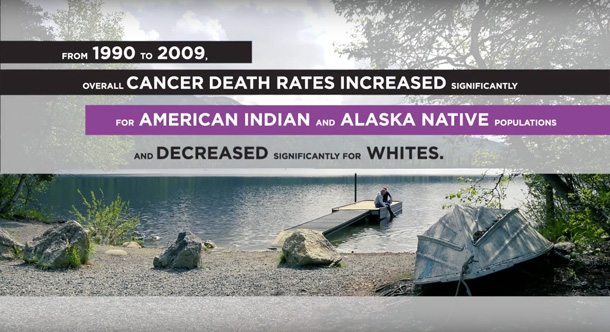
Cancer Control in American Indian and Alaska Native Populations: A Conversation with Dr. Shobha Srinivasan
April 25, 2018, by NCI Staff
American Indian and Alaska Native (AI/AN) populations are among the underserved minority groups in the United States and are disproportionately affected by certain cancers. NCI’s Division of Cancer Control and Population Sciences (DCCPS) supports research to reduce the burden of cancer in these populations, working in collaboration with AI/AN tribes and communities.
In this interview, sociologist Shobha Srinivasan, Ph.D., health disparities research coordinator in DCCPS, discusses some of these disparities and NCI’s efforts to address them. To highlight the cancer control research challenges and opportunities, DCCPS is launching “A Seat at the Table,” a video on cancer control research in AI/AN populations, in recognition of National Minority Health Month and National Cancer Control Month.
What are some examples of the cancer disparities among American Indian and Alaska Native people?
AI/AN populations have the lowest survival rates for nearly all types of cancer of any subpopulation in the United States, with cancers often detected at later stages.
To get a better picture of cancer incidence and mortality in these diverse groups, we have to break down the AI/AN populations by different regions of the country. For example, in the Northern Plains lung cancer is more prevalent among American Indians than among non-Hispanic whites. In the Southern Plains, AI men are more likely than white men to die from colorectal cancer; and in Alaska and the Northwest region, the rate of breast cancer is higher among AI/AN women than among white women.
Do we know what's behind these disparities?
Lung cancer is more prevalent among American Indians in the Northern and Southern Plains primarily because of the higher rate of tobacco use. However, because AI communities use tobacco for traditional purposes, cancer control efforts in these populations must recognize and respect the use of tobacco for traditional and sacred purposes.
Another example is among American Indians in the Southwest, where colorectal cancer screening rates are lower than in the general population due to multiple factors. These factors include a lack of information about the need to get screened and at what age to get screened, as well as inadequate promotion of screening by health care systems. Lack of access to health care for AI/AN people is also a factor in the disparities in colorectal cancer–related incidence, mortality, stage at diagnosis, and survival.
What are some of the unique challenges that researchers face in trying to study cancer control in these populations?
It’s hard to understand and study cancer incidence and mortality in AI/AN communities as a whole because they are not a homogeneous group. There are more than 550 federally recognized tribes in the United States, as well as many that are not recognized at the federal level. About 300 federally recognized tribes live in Alaska alone.
The issue of trust is also important because there is a history of broken treaties and broken promises. And trust includes issues of ethics and respect and preventing the misuse of data.
Because of this history, tribes now take very seriously the review of protocols for a study. They want to be true partners in studies, and they require that the information be given back to their communities in a way that is easily understood and explained, so that they can use the information to improve the health of the people in their communities.
Some researchers do a very good job of sharing their findings with tribal communities, but it requires a lot of patience and relationship building to make sure that it's done well and that the research is conducted ethically.
Studying Small Populations
In January 2018, NCI co-sponsored a workshop on improving health research on small populations. The workshop, held at the National Academies of Sciences, Engineering, and Medicine, covered issues, such as research methods and ethical concerns, to consider when conducting health research on small, underrepresented population subgroups, including AI/AN communities. A report from the workshop will be released in June 2018.
In January 2018, NCI co-sponsored a workshop on improving health research on small populations. The workshop, held at the National Academies of Sciences, Engineering, and Medicine, covered issues, such as research methods and ethical concerns, to consider when conducting health research on small, underrepresented population subgroups, including AI/AN communities. A report from the workshop will be released in June 2018.
There's also the question of who ultimately owns the data and how the data will be used and published. The issue of data ownership is an issue of sovereignty for the tribes, because in the past some researchers have used the data for something other than the purpose of the original study without the tribes' knowledge.
Another challenge, at least as far as NCI is concerned, is that AI/AN populations are small populations, and randomized clinical trials typically require reasonably large numbers of participants to be statistically rigorous.
These are some basic rules and concepts that we need to understand before we initiate research with AI/AN populations. Our methods, our approaches, and the formulation of our research questions must involve thinking outside the box of our traditional assumptions and the range of issues we usually deal with when studying cancer control.
How is NCI working to improve collaboration between researchers and Native communities to address these challenges?
One of the most important things we have done is join forces with seven other NIH institutes/offices to launch the Intervention Research to Improve Native American Health(IRINAH) program in 2011. Joining forces was a benefit because some of our NIH institute partners in IRINAH had much more experience than NCI in working successfully with AI/AN communities.
The IRINAH program funds research to develop, adapt, and test the effectiveness of health-promotion and disease-prevention approaches in AI/AN populations, with the long-term goal of reducing disease and death in these groups.
Projects funded through IRINAH must include the AI/AN tribe or community as an equal partner with the research institution, with members of the community involved in nearly every aspect of the research, including helping to design the study and disseminate the findings. This program, which funds more than 25 projects across the 8 partner institutes, also created a network of researchers who we can talk to and learn from about how to move the science forward in this area to benefit the tribes and communities.
In 2015, NIH also created a Tribal Health Research Office that coordinates tribal research activities across NIH. Subsequently, NIH established its own advisory committee for the tribes, so that NCI and the other institutes can get information from the tribes directly and be more responsive to specific issues that they would like to have addressed.
For example, we tried to gear the announcement of IRINAH toward wellness and overall health, and not toward specific diseases, because the AI/AN concept of health is not one of disease but of wellness and how well you live in harmony with nature, family, and community.
What are some examples of research in this area being pursued by NCI?
A good example is a study we are funding through IRINAH that is aimed at reducing tobacco use among pregnant women in Alaska Native communities by creating relationships between pregnant women and female elders in the community.
Another IRINAH study is testing approaches to enhance colorectal cancer screening and follow-up care among American Indians in the Southwest. This study is a collaboration between the University of New Mexico, the American Indian-owned and -operated Albuquerque Area Indian Health Board, and six Pueblo Tribes in the rural Southwest.
These studies are ongoing, so we don’t yet have published results.
In addition, NCI's Center to Reduce Cancer Health Disparities (CRCHD) has several programs that fund community-research partnerships and training for minority fellows. One such program, the Partnerships to Advance Cancer Health Equity (PACHE), funds the Partnership for Native American Cancer Prevention, a collaboration between the University of Arizona Cancer Center and Northern Arizona University (NAU) to train AI/AN students for careers in cancer-related research and health care; build the cancer-related research capacity at NAU; and alleviate disparities in cancer in AI/AN communities.
Investigators who work in this area often talk about "culturally based science" or "culturally based cancer research." What is this and why is it important?
Every intervention designed to improve health or health outcomes—not just those designed to help underserved communities—is responsive to a particular culture and context. When we try to replicate or develop interventions in other communities and contexts, we need to consider factors that are relevant to the context in which people live, and the realities of their world.
AI/AN tribes and communities have a general concept of health and well-being. For example, when we were developing the IRINAH program, tribal elders and researchers who work with AI/AN communities told us that some AI/AN individuals, after receiving a cancer diagnosis, would first like to talk to their traditional healer and get their blessing before starting treatment. The person diagnosed with cancer may feel that the whole family needs to come together and have a traditional healing performed for their overall health.
These discussions take various forms in different communities, and it's a matter of understanding that and incorporating it into NCI's way of thinking.
We now understand that a diagnosis of cancer is not an individual's diagnosis—it's a diagnosis that affects a person's entire family and support group. For example, a person with cancer may need someone to take them to and from treatment, which in some AI/AN communities or other rural communities could be 6 or 7 hours away.
By integrating culture into the intervention approach and into the research questions, study design, measures, and interpretation of results, we are able to be culturally responsive and accurately assess the study's effectiveness within that context.

























.png)











No hay comentarios:
Publicar un comentario